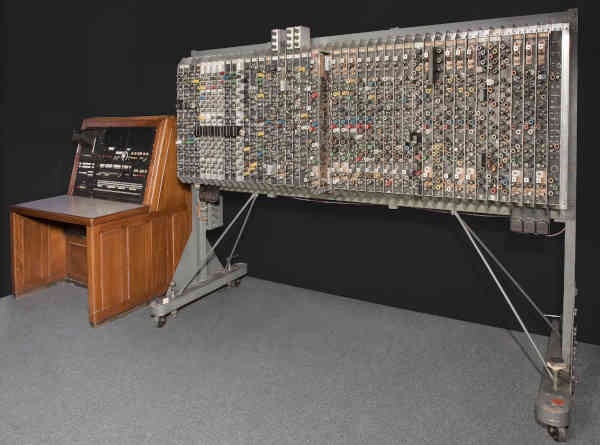
What marks did Turing leave behind?
- Post Office Research Station, Dollis Hill (London Northwest)
The Colossus vacuum tube computer (1943) was built to decode the secret messages of the German Lorenz cryptographic machine. The person responsible was Thomas Flowers. Although the Colossus remained secret until 1975, this machine influenced the efforts at the University of Manchester. Alan Turing did not participate in the development of the Colossus. - National Physical Laboratory, Teddington (London)
In 1945, Alan Turing designed a stored program vacuum tube computer with the name Ace for John Womersley. However, delays ensued with its construction (Pilot Ace, 1950) (see Fig. 1). The disillusioned Turing left before its completion for the University of Manchester. - Cambridge University
Maurice Wilkes was given a brief insight into the pioneering work on the von Neumann computer (1945) by Douglas Hartree. This report came about in connection with the Eniac electronic computer. A visit to the lecture series at the University of Pennsylvania in Philadelphia (1946) was the inspiration for his resolve to build a computer. This resulted in the Edsac stored program vacuum tube machine of 1949. - University of Manchester
In Bletchley Park, Max Newman recognized the capabilities of digital computers. In 1945, he proposed that the University of Manchester should develop an electronic computer and pointed out the existence of the Colossus. The stored program Manchester Baby, built by Frederic Williams and Thomas Kilburn, first saw the light of day in 1948. Kilburn had attended lecture series of Wilkinson and Turing on computer design in 1946/47. The Manchester experimental computer operated initially in June 1948. Alan Turing only came to the University of Manchester in September 1948, by which time the project was well underway.
Fig. 1: The Pilot Ace. Alan Turing designed the Automatic computing engine (Ace)
at the National Physical Laboratory in London.
The trial machine was finished in 1950.
The Pilot Ace is one of the few surviving electronic digital computers from the early days.
Credit: Science Museum, London/Science & society picture library
Conclusions
The groundbreaking work on the (universal) Turing machine was published in 1936/37. From this theoretical model to Turing’s design of the Ace vacuum tube computer (1945), several years had passed. The plugboard-controlled Colossus (1943) was not a stored program machine. It appears that Wilkes only became aware of the importance of future-oriented digital computers by way of a detour through the U.S.
The Ace reveals the direct influence of Turing. In Manchester, where he drafted the specifications for the input-output unit and wrote the programming manual, his hand is less apparent. The stored program machines constructed in Cambridge and Manchester reflect the von Neumann architecture. Turing probably had little influence on computer construction. Even with the British stored program machines, with the exception of the Ace, he contributed little or nothing at all. At least in the beginning, the builders of the first relay and vacuum tube computers (Aiken, Atanasoff, Eckert, Lebedev, Mauchly, Stibitz, and Zuse) were not aware of Turing’s pioneering concepts. With the exception of Lebedev, their early machines were not stored program computers.
References
Bruderer, Herbert: Meilensteine der Rechentechnik, De Gruyter Oldenbourg, Berlin/Boston, 3. Auflage 2020, Band 1, 970 Seiten, 577 Abbildungen, 114 Tabellen, https://www.degruyter.com/view/title/567028?rskey=xoRERF&result=7
Bruderer, Herbert: Meilensteine der Rechentechnik, De Gruyter Oldenbourg, Berlin/Boston, 3. Auflage 2020, Band 2, 1055 Seiten, 138 Abbildungen, 37 Tabellen, https://www.degruyter.com/view/title/567221?rskey=A8Y4Gb&result=4
Bruderer, Herbert: Milestones in Analog and Digital Computing, Springer Nature Switzerland AG, Cham, 3rd edition 2020, 2 volumes, 2113 pages, 715 illustrations, 151 tables, translated from the German by John McMinn, https://www.springer.com/de/book/9783030409739
Campbell-Kelly, Martin et al.: Computer. A history of the information machine, Westview Press, Boulder, Colorado, 3rd edition 2016, page 77
Campbell-Kelly, Martin: The Ace and the shaping of British computing, in: Brian Jack Copeland (ed.): Alan Turing’s electronic brain, Oxford 2012, pages 152 and 153
Colebrook, Francis: Le modèle pilote du calculateur automatique électronique arithmétique (Ace) du NPL, in: Joseph Pérès (ed.): Les machines à calculer et la pensée humaine, Paris, January 8–13 1951, Colloques internationaux du Centre national de la recherche scientifique, Editions du Centre national de la recherche scientifique, Paris 1953, page 65
Copeland, Brian Jack: The Manchester computer: A revised history. Part 2: The baby computer, in: IEEE Annals of the history of computing, volume 33, 2011, no. 1, pages 22 and 23.
Daylight, Edgar: The dawn of software engineering, Heverlee 2012, pages 1–6, 13–14, 41–42, and 187–197
Goldstine, Herman Heine: The computer from Pascal to von Neumann, Princeton University Press, Princeton, New Jersey 1993, pages 217 and 321
Haigh, Thomas; Priestley, Mark: Historical reflections. Von Neumann thought Turing’s universal machine was ‘simple and neat.’ But that didn’t tell him how to design a computer, in: Communications, volume 63, January 2020, issue 1, pages 26–32.
Lavington, Simon: Early British computers, Manchester University Press, Manchester 1980, page 53.
Lavington, Simon: Swords and ploughshares: Connections between computer projects for war and peace, 1945–55, in: Cliff B. Jones; John L. Lloyd (eds.): Dependable and historic computing, Springer-Verlag, Heidelberg 2011, pages 316–317.
Priestley, Mark: A science of operations, Springer-Verlag, London 2011, page 125
Randell, Brian: The Colossus, in: Nicholas Constantine Metropolis; Jack Howlett; Gian-Carlo Rota (eds.): A history of computing in the twentieth century, Academic Press, New York, London 1980, page 86
Wang, Hao: A variant to Turing’s theory of computing machines, in: Journal of the Association for Computing Machinery, volume 4, 1957, no 1, page 63
Wilkes, Maurice: Memoirs of a computer pioneer, MIT Press, Cambridge, Massachusetts, London 1985, pages 135–137
Herbert Bruderer (herbert.bruderer@bluewin.ch; bruderer@retired.ethz.ch) is a retired lecturer in the Department of Computer Science at ETH Zurich and a historian of technology.




Join the Discussion (0)
Become a Member or Sign In to Post a Comment